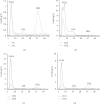Effect of Aqueous Extract and Polyphenol Fraction Derived from Thymus atlanticus Leaves on Acute Hyperlipidemia in the Syrian Golden Hamsters
- PMID: 32308705
- PMCID: PMC7142347
- DOI: 10.1155/2020/3282596
Effect of Aqueous Extract and Polyphenol Fraction Derived from Thymus atlanticus Leaves on Acute Hyperlipidemia in the Syrian Golden Hamsters
Abstract
Thymus atlanticus, an endemic plant of Morocco, is traditionally used as a liniment or a drink to treat various diseases. However, there are few available scientific data regarding its biological effects. In this connection, the present study aimed to investigate the hypolipidemic and antioxidant effects of aqueous extract and polyphenol fraction of Thymus atlanticus in Syrian golden hamsters treated with Triton WR-1339 (triton, 20 mg/100 g body weight). The hamsters orally received the extracts (400 mg/kg), and blood samples were collected after 24 h of treatment to determine plasma lipid, insulin, and fasting blood glucose levels. Plasma malondialdehyde level and plasma total antioxidant (TAS) were also evaluated. The T. atlanticus extracts significantly decreased triglycerides, total cholesterol, VLDL-C, and LDL-C and increased HDL-C when compared with the hyperlipidemic group. Both extracts suppressed the effect of the triton injection on TAS and reduced the level of plasma malondialdehyde. The extracts produced no significant change in the blood glucose level but effectively prevented the mild hyperinsulinemia induced by triton. These findings suggest that T. atlanticus may be a useful alternative treatment for the control of hyperlipidemia and its related diseases.
Copyright © 2020 Mhamed Ramchoun et al.
Conflict of interest statement
The authors declare that they have no conflicts of interest.
Figures




Similar articles
-
Thymus atlanticus: A Source of Nutrients with Numerous Health Benefits and Important Therapeutic Potential for Age-Related Diseases.Nutrients. 2023 Sep 21;15(18):4077. doi: 10.3390/nu15184077. Nutrients. 2023. PMID: 37764861 Free PMC article. Review.
-
Effect of supplementation with polyphenol extract of Thymus atlanticus on paraoxonase-1 activity, insulin resistance, and lipid profile in high-fat diet-fed hamsters.J Food Biochem. 2022 Sep;46(9):e14225. doi: 10.1111/jfbc.14225. Epub 2022 May 16. J Food Biochem. 2022. PMID: 35575425
-
Thymus atlanticus (Ball) Roussine Exerted Anti-Hyperlipidemic, Anti-Hyperglycemic, and Hepatoprotective Effects in High-Fat and Sucrose Diet-Fed Rats.Curr Drug Discov Technol. 2025 May 7. doi: 10.2174/0115701638335977241228171318. Online ahead of print. Curr Drug Discov Technol. 2025. PMID: 40337963
-
Hypoglycemic and hypolipidemic effects of an aqueous extract of Chamaerops humilis leaves in obese, hyperglycemic and hyperlipidemic Meriones shawi rats.Pak J Pharm Sci. 2010 Apr;23(2):212-9. Pak J Pharm Sci. 2010. PMID: 20363702
-
Evaluation of hypolipidemic Marrubium vulgare effect in Triton WR-1339-induced hyperlipidemia in mice.Asian Pac J Trop Med. 2016 May;9(5):453-9. doi: 10.1016/j.apjtm.2016.03.038. Epub 2016 Mar 23. Asian Pac J Trop Med. 2016. PMID: 27261853
Cited by
-
Thymus atlanticus: A Source of Nutrients with Numerous Health Benefits and Important Therapeutic Potential for Age-Related Diseases.Nutrients. 2023 Sep 21;15(18):4077. doi: 10.3390/nu15184077. Nutrients. 2023. PMID: 37764861 Free PMC article. Review.
-
Green-synthesized nanoparticles of the polyherbal extract attenuate the necrosis of pancreatic β-cell in a streptozotocin-induced diabetic model.Heliyon. 2023 May 15;9(5):e16137. doi: 10.1016/j.heliyon.2023.e16137. eCollection 2023 May. Heliyon. 2023. PMID: 37251822 Free PMC article.
-
Antimicrobial Potential and Phytochemical Profile of Wild and Cultivated Populations of Thyme (Thymus sp.) Growing in Western Romania.Plants (Basel). 2021 Sep 3;10(9):1833. doi: 10.3390/plants10091833. Plants (Basel). 2021. PMID: 34579365 Free PMC article.
-
Polyphenol Extract from "Greco" Grape Canes: Characterization, Antioxidant Capacity, and Antitumor Effects on Cal-33 and JHU-SCC-011 Head and Neck Squamous Cell Carcinoma.Molecules. 2022 Apr 15;27(8):2576. doi: 10.3390/molecules27082576. Molecules. 2022. PMID: 35458774 Free PMC article.
-
Phenolic Content Analysis of Two Species Belonging to the Lamiaceae Family: Antioxidant, Anticholinergic, and Antibacterial Activities.Molecules. 2024 Jan 18;29(2):480. doi: 10.3390/molecules29020480. Molecules. 2024. PMID: 38257392 Free PMC article.
References
-
- Cardiovascular diseases (CVDs). https://www.who.int/news-room/fact-sheets/detail/cardiovascular-diseases...
-
- Saeed A., Feofanova E., Yu B., et al. Association of elevated triglycerides and atherogenic lipoproteins with incident cardiovascular diseases: insights from genetic data in the atherosclerosis risk in communities study. Journal of Clinical Lipidology. 2017;11(3):p. 788. doi: 10.1016/j.jacl.2017.04.028. - DOI
-
- WHO. Raised Cholesterol. Geneva, Switzerland: WHO; 2015.
-
- Sultan S., D’Souza A., Zabetakis I., et al. The Impact of Nutrition and Statins on Cardiovascular Diseases. Amsterdam, Netherlands: Elsevier; 2019. Statins: rationale, mode of action, and side effects; pp. 171–200.
-
- Ramchoun M., Harnafi H., Alem C., et al. Hypolipidemic and antioxidant effect of polyphenol-rich extracts from Moroccan thyme varieties. e-SPEN Journal. 2012;7(3):e119–e124. doi: 10.1016/j.clnme.2012.02.005. - DOI
LinkOut - more resources
Full Text Sources

